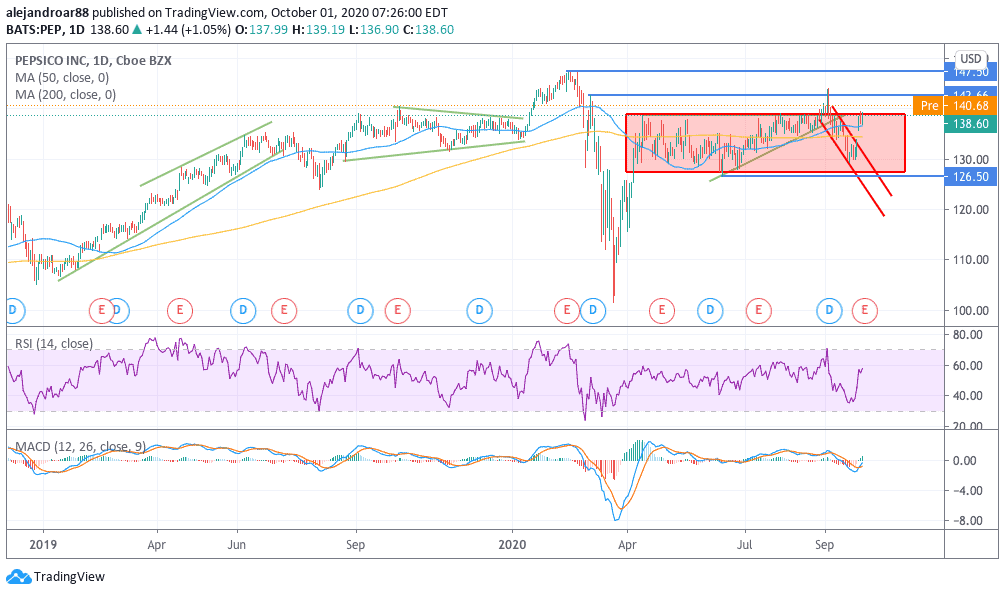PepsiCo shares are rising 1.5% during this morning pre-market stock trading activity on Wall Street after the company successfully beat earnings, revenues, and full-year outlook forecasts for the third quarter of 2020.
The snacks giant reported $18.09bn in revenues during the three-month period ended on 5 September, which represented a 5% jump compared to the $17.19bn it brought a year ago while also 5% above analysts’ expectations of $17.24bn for the quarter.
This growth can be partially attributed to a 31% increase in PepsiCo sales in Africa, the Middle East, and South Asia, along with a 15% jump in its revenues in Asia Pacific, Australia, New Zealand, and China region.
However, the Latin American segment showed a 15% drop in revenues during the 12 weeks covered by the report, while sales in North America and Europe grew at a slower rate of 7% and 3% respectively.
Core earnings per share for the quarter – a non-GAAP measure – landed at $1.66 per share vs. $1.56 the company reported the year before – while they also surpassed the Street’s estimate of $1.49 per share.
The Harrison-based company provided full-year guidance that included $5.5 in core earnings per share for the 12-month period – 13 cents higher than analysts’ estimates – along with a forecasted organic revenue growth rate of 4%.
Additionally, PepsiCo expects to return around $7.5bn to shareholders this year including $5.5bn in dividends and $2bn in the form of stock buybacks.
Are PepsiCo shares a buying opportunity based on these news?

PepsiCo shares recently slid from a previous post-pandemic high of $143 per share, following the broad-market correction that we saw during September.
The latest price action shows that the stock has been trading range-bound since a strong rebound off its March lows, moving between $127 and $140 during the 6 months that followed with only one failed break of that price channel in early September.
Today’s uptick could potentially break that price channel again and could end up retesting the $143 level. If that were to happen a new high in the RSI could be the indication that the stock will attempt to move even higher – possibly towards its all-time highs February.
However, traders should keep an eye on a potentially weaker RSI reading if a new high is reached, which would create a bearish divergence in the oscillator – an indicator that the stock’s momentum is weaker than it was during that previous failed break.
Trusted & Regulated Stock & CFD Brokers
What we like
- 0% Fees on Stocks
- 5000+ Stocks, ETFs and other Markets
- Accepts Paypal Deposits
Min Deposit
$200
Charge per Trade
Zero Commission on real stocks
64 traders signed up today
Visit Now67% of retail investor accounts lose money when trading CFDs with this provider. You should consider whether you can afford to take the high risk of losing your money.
Available Assets
- Total Number of Stocks & Shares5000+
- US Stocks
- German Stocks
- UK Stocks
- European
- ETF Stocks
- IPO
- Funds
- Bonds
- Options
- Futures
- CFDs
- Crypto
Charge per Trade
- FTSE 100 Zero Commission
- NASDAQ Zero Commission
- DAX Zero Commission
- Facebook Zero Commission
- Alphabet Zero Commission
- Tesla Zero Commission
- Apple Zero Commission
- Microsoft Zero Commission
Deposit Method
- Wire Transfer
- Credit Cards
- Bank Account
- Paypall
- Skrill
- Neteller
What we like
- Sign up today and get $5 free
- Fractals Available
- Paypal Available
Min Deposit
$0
Charge per Trade
$1 to $9 PCM
Visit Now
Investing in financial markets carries risk, you have the potential to lose your total investment.
Available Assets
- Total Number of Shares999
- US Stocks
- German Stocks
- UK Stocks
- European Stocks
- EFTs
- IPOs
- Funds
- Bonds
- Options
- Futures
- CFDs
- Crypto
Charge per Trade
- FTSE 100 $1 - $9 per month
- NASDAQ $1 - $9 per month
- DAX $1 - $9 per month
- Facebook $1 - $9 per month
- Alphabet $1 - $9 per month
- Telsa $1 - $9 per month
- Apple $1 - $9 per month
- Microsoft $1 - $9 per month
Deposit Method
- Wire Transfer
- Credit Cards
- Bank Account




